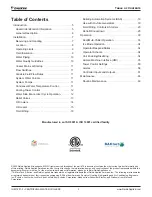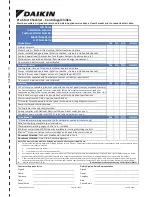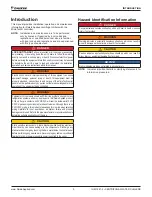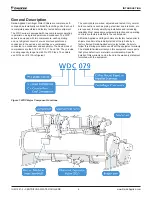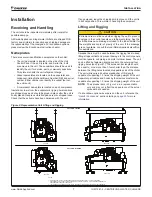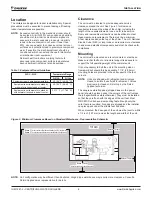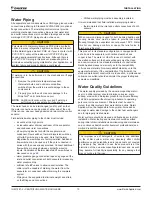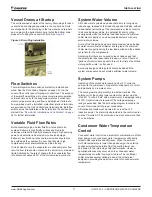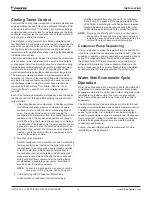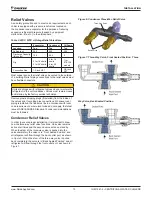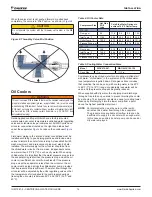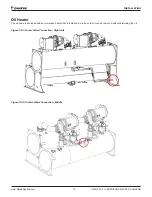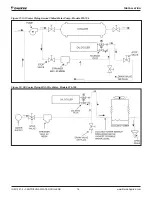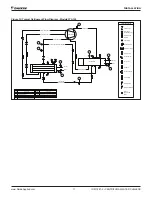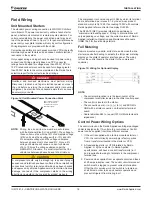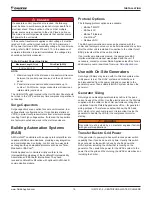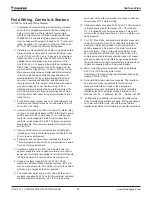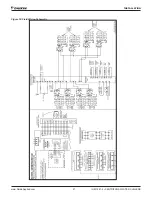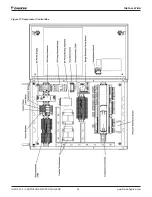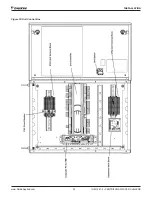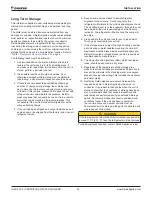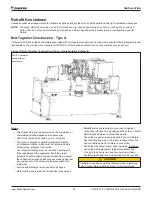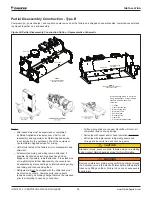
Installation
www.DaikinApplied.com 11
IOM 1281-2 • CENTRIFUGAL WATER CHILLERS
Vessel Drains at Startup
The unit is drained of water at the factory. Drain plugs for each
vessel head are shipped separately in the control box. Units
are shipped with the drain plug in the top water box drain hole
and no plug in the bottom drain hole. Install the bottom drain
plugs prior to filling the vessel with fluid. See
Figure 5
Figure 5: Drain Plug Installation
Flow Switches
Thermal dispersion flow switches are factory-installed and
wired. See the Field Wiring Diagram on page 32 or on the
cover of the control panel for proper connections. The purpose
of the water flow switches is to prevent compressor operation
until such time as both the evaporator water and condenser
water pumps are running and flow is established. If alternate
flow switches must be furnished, water flow interlock terminals
are provided on the Unit Control Panel terminal strip. Both flow
switches must be calibrated in the field before the unit can be
started. See
“Flow Switch Installation and Calibration” on page
68
for further information.
Variable Fluid Flow Rates
Both excessively high and low fluid flow rates should be
avoided. Extremely high fluid flow rates and high tube
velocities will result in high fluid pressure drops, high pumping
power, and potential tube erosion or corrosion damage.
Extremely low fluid flow rates and low velocities should also
be avoided as they will result in poor heat transfer, high
compressor power, sedimentation and tube fouling.
If it is decided to vary the evaporator or condenser water flow
rate, the flow rate should not exceed the minimum or maximum
limits. Additionally, the rate of change for the evaporator flow
rate should not exceed 50% of the current value per minute.
System Water Volume
All chilled water systems need adequate time to recognize a
load change, respond to that load change and stabilize, without
undesirable short cycling of the compressors or loss of control.
In air conditioning systems, the potential for short cycling
usually exists when the building load falls below the minimum
chiller plant capacity or on close-coupled systems with very
small water volumes.
Some of the things the designer should consider when looking
at water volume are the minimum cooling load, the minimum
chiller plant capacity during the low load period and the desired
cycle time for the compressors.
Assuming that there are no sudden load changes and that
the chiller plant has reasonable turndown, a rule of thumb of
“gallons of water volume equal to three to four times the chilled
water gpm flow rate” is often used.
A properly designed storage tank should be added if the
system components do not provide sufficient water volume.
System Pumps
Operation of the chilled water pump can be to 1) cycle the
pump with the compressor, 2) operate continuously, or 3) start
automatically by a remote source.
The cooling tower pump must cycle with the machine. The
holding coil of the cooling tower pump motor starter must be
rated at 115 volts, 60 Hz, with a maximum volt-amperage rating
of 100. A control relay is required if the voltage-amperage
rating is exceeded. See the field wiring diagram located in the
cover of control panel for proper connections.
All interlock contacts must be rated for no less than 10
inductive amps. The alarm circuit provided in the control center
utilizes 115-volts AC. The alarm used must not draw more than
10 volt amperes.
Condenser Water Temperature
Control
Condenser water control is an important consideration in chiller
plant design since condenser water temperature will directly
impact chiller operation and efficiency. When the ambient
wet bulb temperature is lower than peak design, the entering
condenser water temperature from the cooling tower can
be allowed to fall, improving chiller performance. However,
operational issues may occur when the condenser water
temperatures are either too high or too low. The centrifugal
chiller provides several options to assist the chiller plant
designer in providing the optimum control of condenser water
temperature.


